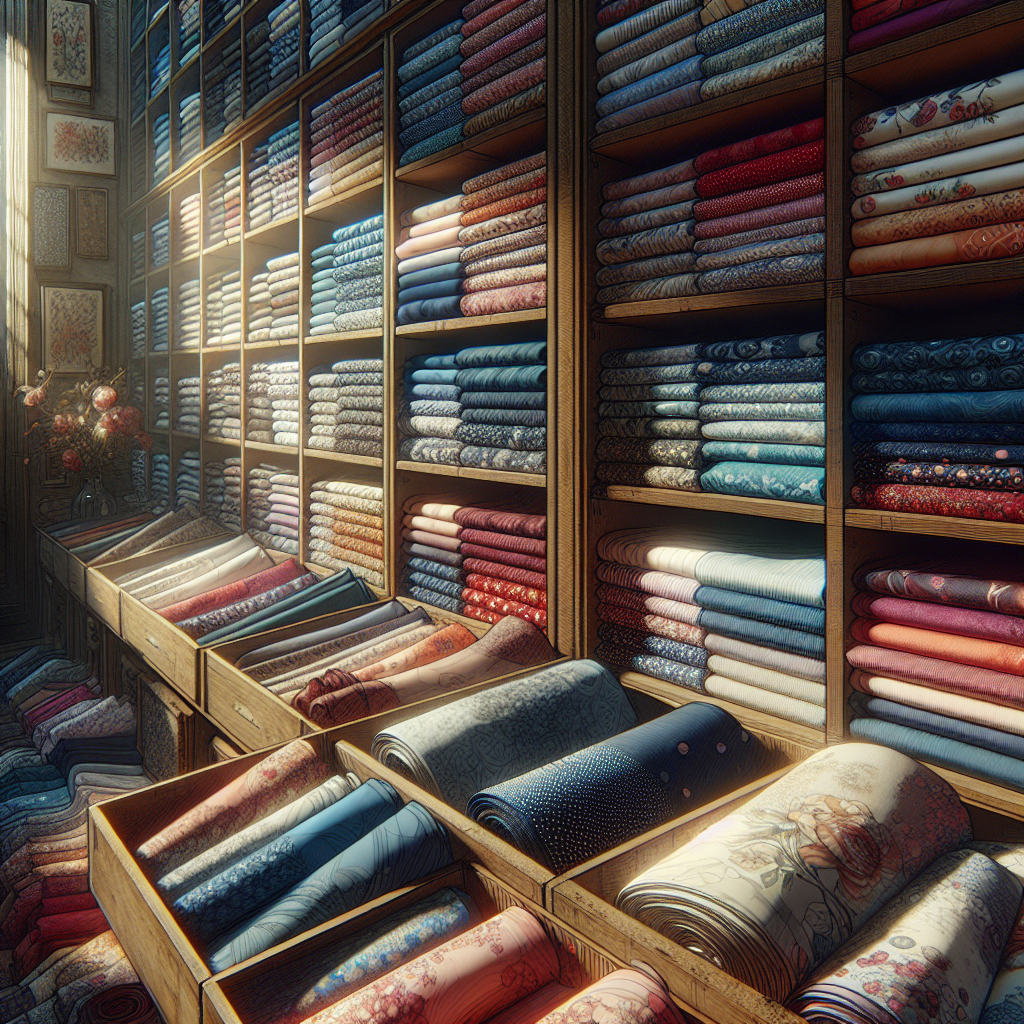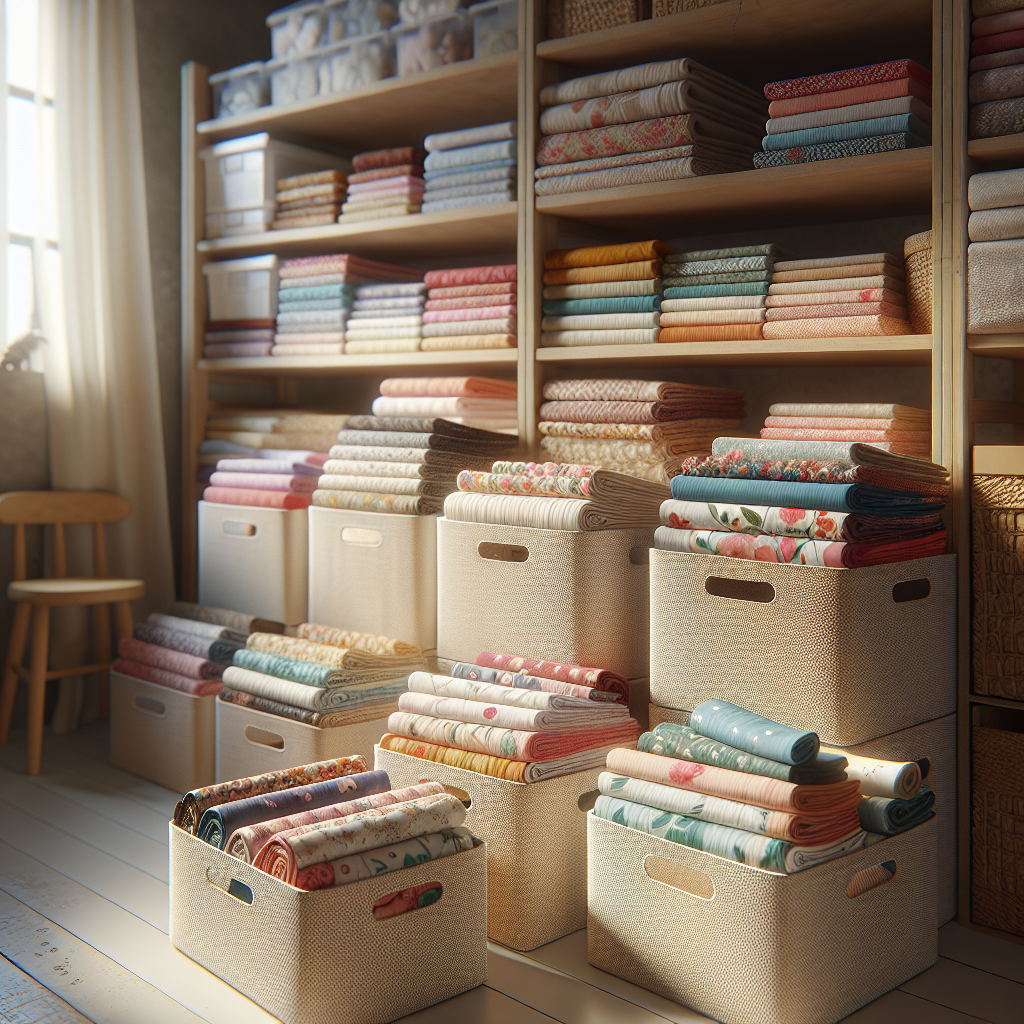When it comes to sewing, one of the most crucial factors that can influence the longevity and quality of your projects is proper fabric storage. Fabrics are not merely pieces of material; they are investments in creativity and craftsmanship. Understanding how to store your fabric correctly can prevent common issues such as fading, tearing, and the accumulation of dust.
Many sewing enthusiasts underestimate the significance of adequate storage solutions, leading to damaged materials that can hinder their projects. Here are some essential tips for storing fabric to avoid damage:
- Keep it Clean: Always ensure your fabrics are clean and dry before storing them. Stains can set over time, making them difficult to remove.
- Avoid Direct Sunlight: Ultraviolet rays can fade colors and weaken fibers. Store your fabric in a cool, dark place.
- Use Appropriate Containers: Choose breathable containers like fabric boxes or bins, rather than plastic bags, to prevent moisture buildup.
- Organize by Type: Grouping similar fabrics together can make it easier to find what you need while minimizing the risk of damage.
By taking the time to implement these strategies, you can ensure that your fabrics remain in pristine condition, ready for your next sewing endeavor. If you’re eager to dive deeper into fabric storage strategies, visit our website to learn more and get started today! Click here.
Choosing the Right Storage Solutions for Fabrics

Selecting the right storage solutions for your fabrics is essential to maintaining their quality and extending their lifespan. The choices you make in how you organize and store your materials can significantly impact their usability for future projects. Here are some valuable considerations to keep in mind when choosing appropriate storage solutions:
- Fabric Bins: Clear plastic bins or fabric boxes are excellent options because they keep dust away and allow you to see the contents at a glance. Ensure that they are breathable to prevent moisture buildup.
- Shelves and Drawers: Dedicated shelves or drawers can help keep fabrics organized. Consider using drawer dividers to separate different types of materials, making it easier to find what you need.
- Rolling Carts: A rolling cart can provide easy access to your fabric collection. This solution is particularly useful for those who have limited space and want the flexibility to move their supplies around.
- Hanging Storage: For larger pieces or specialty fabrics, consider using a hanging storage system. This method can prevent wrinkles and is perfect for keeping the fabric visible and accessible.
When choosing storage solutions, remember to consider the type of fabric you are storing. Delicate fabrics may require more gentle handling and protection than sturdier materials. By investing in the right storage options, you can create a well-organized and efficient sewing space that enhances your creative process.
How to Organize Your Fabric Collection Effectively

Organizing your fabric collection effectively can transform your sewing space and streamline your creative process. A well-structured collection not only saves time but also inspires you with visual prompts for your next project. Here are some tips for organizing fabric that will help you maintain a tidy and accessible inventory:
- Sort by Type: Begin by categorizing your fabrics based on their type—cotton, linen, silk, and so forth. This categorization makes it easier to locate specific materials when you’re ready to sew.
- Utilize Color Coding: Within each category, consider organizing fabrics by color. This method not only looks aesthetically pleasing but also helps in quickly finding the right shade for your project.
- Label Containers: If you store your fabrics in bins or boxes, label them clearly. Use a labeling system that includes the type of fabric and its size, which aids in efficient retrieval.
- Keep Small Scraps Together: For smaller remnants, designate a separate container or drawer. This allows you to easily access fabric scraps for projects like patchwork or small accessories.
- Regularly Reassess: Make it a habit to periodically revisit your collection. Remove any materials that you no longer plan to use, and make adjustments to your organization as needed.
By implementing these organization techniques, you’ll not only optimize your workspace but also spark creativity as you explore your fabric options. An organized fabric collection can serve as a source of inspiration, encouraging you to take on new and exciting sewing challenges.
Best Practices for Folding and Rolling Fabrics
Properly folding and rolling fabrics is crucial to preserving their quality and preventing damage over time. Employing the right techniques can help you maximize storage space while keeping your materials ready for your next sewing project. Here are some best practices for folding and rolling fabrics that you can easily adopt:
- Folding Fabrics: For larger pieces, start by laying the fabric flat on a clean surface. Fold it in half lengthwise, aligning the edges. Then, make a series of gentle folds, approximately 10-12 inches wide, until the fabric is compact. This method minimizes creases and allows for easy stacking.
- Rolling Fabrics: If you prefer to roll your fabrics, begin by laying the fabric face down. Smooth out any wrinkles before rolling from one end to the other, ensuring the roll is tight but not overly compressed. This technique is particularly useful for delicate fabrics, as it reduces the risk of permanent creases.
- Storing Techniques: Whether you fold or roll, store your fabrics in a cool, dry place away from direct sunlight. Consider using acid-free tissue paper between layers to prevent color transfer and maintain fabric integrity.
- Use Fabric Storage Bins: Invest in clear bins or containers to store your folded or rolled fabrics. This not only protects them from dust and dirt but also allows for easy visibility, helping you quickly locate what you need.
- Avoid Overcrowding: Be mindful not to overcrowd your storage space. Overstuffing can lead to unwanted creasing and damage. Instead, leave some room for air circulation and ensure each piece can be accessed easily.
Implementing these folding and rolling techniques will help keep your fabric collection in pristine condition, making it easier for you to enjoy your sewing projects without the hassle of damaged materials.
Climate Control Tips to Protect Your Fabric

Maintaining the right climate for your fabric storage is essential to prevent damage from moisture, heat, and pests. Here are some climate control tips to protect your fabric that every sewing enthusiast should consider:
- Monitor Humidity Levels: Fabrics are sensitive to humidity. Ideally, the storage environment should maintain a relative humidity of around 35-50%. Use a hygrometer to regularly check humidity levels and consider using a dehumidifier in damp climates or during rainy seasons.
- Temperature Control: Keep your fabric in a temperature-controlled area, avoiding extremes. The ideal temperature for fabric storage is between 60-75°F (15-24°C). Extreme heat can cause fabrics to fade or become brittle, while excessive cold may lead to stiffness or cracking.
- Air Circulation: Ensure there is good air circulation in your storage area. Avoid placing fabrics in sealed plastic bags for long periods, as this can trap moisture and lead to mildew. Instead, use breathable cotton or linen bags for protection.
- Protect from Direct Sunlight: Prolonged exposure to sunlight can cause fading and weaken fabric fibers. Store your fabrics in a shaded or dark area, and consider using UV-filtering film on windows if your storage space receives a lot of light.
- Pest Prevention: Keep an eye out for pests such as moths and silverfish, which can damage fabrics. Use natural deterrents like cedar blocks or lavender sachets in your storage area to repel insects while adding a pleasant fragrance.
By implementing these climate control tips, you can significantly enhance the longevity of your fabric collection, ensuring that each piece remains vibrant, intact, and ready for your next creative endeavor.
Common Mistakes to Avoid When Storing Fabric

When it comes to storing fabric, there are several common mistakes that can lead to damage or deterioration. Being aware of these pitfalls can help you maintain your fabric in pristine condition. Here are some key mistakes to avoid:
- Ignoring Fabric Type: Different fabrics require different care. For example, delicate materials like silk and lace should not be stored in the same way as sturdy cotton or denim. Always consider the specific needs of each fabric type.
- Overcrowding Storage Spaces: Stuffing too much fabric into one container can lead to creases, wrinkles, and even permanent damage. Instead, opt for spacious storage solutions that allow your fabric to breathe and maintain its shape.
- Using Non-Breathable Materials: Avoid plastic containers that do not allow air circulation. Instead, choose breathable options like cotton or linen bags that protect your fabric while preventing moisture buildup.
- Neglecting to Clean Fabrics: Storing dirty or stained fabrics can lead to permanent marks or attract pests. Always wash or at least spot clean your fabrics before storing them away.
- Forgetting to Rotate Fabrics: Just like any other stored items, fabrics should be rotated regularly to prevent creasing and fading. Make it a habit to check your fabric stash and use or rearrange it periodically.
By being mindful of these common mistakes, you can ensure that your fabric collection remains in excellent condition for all your sewing projects. Visit our website to learn more and get started today! Click here.

